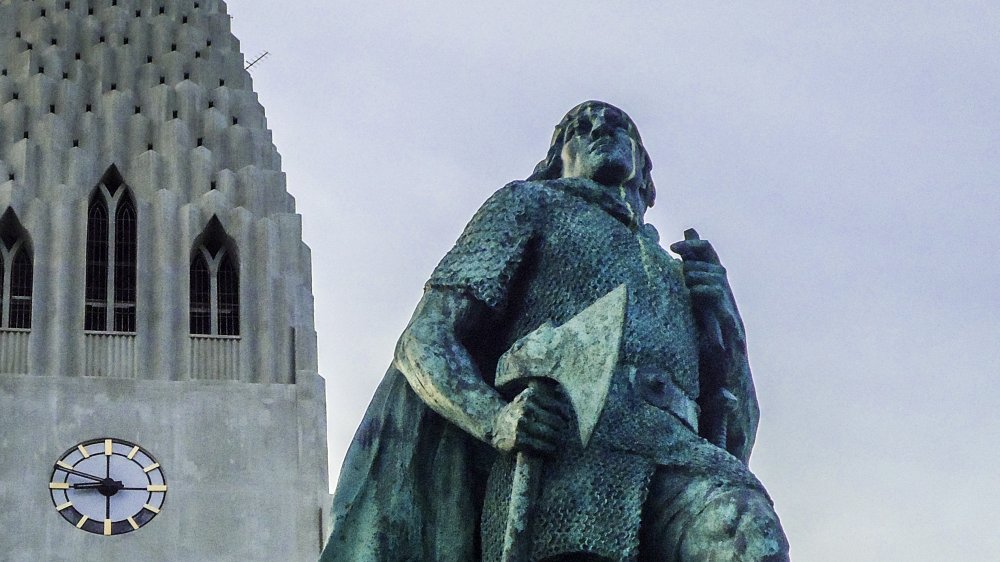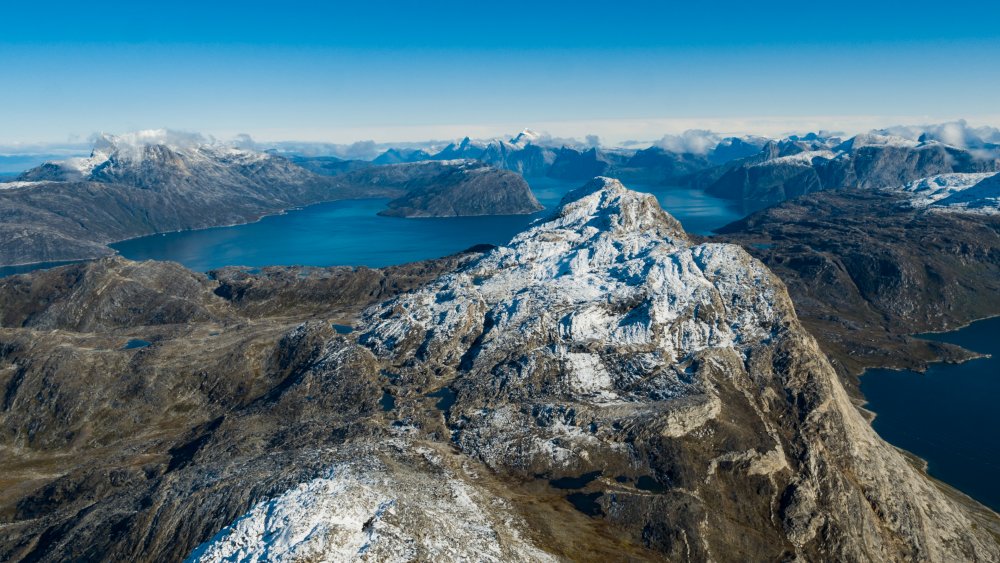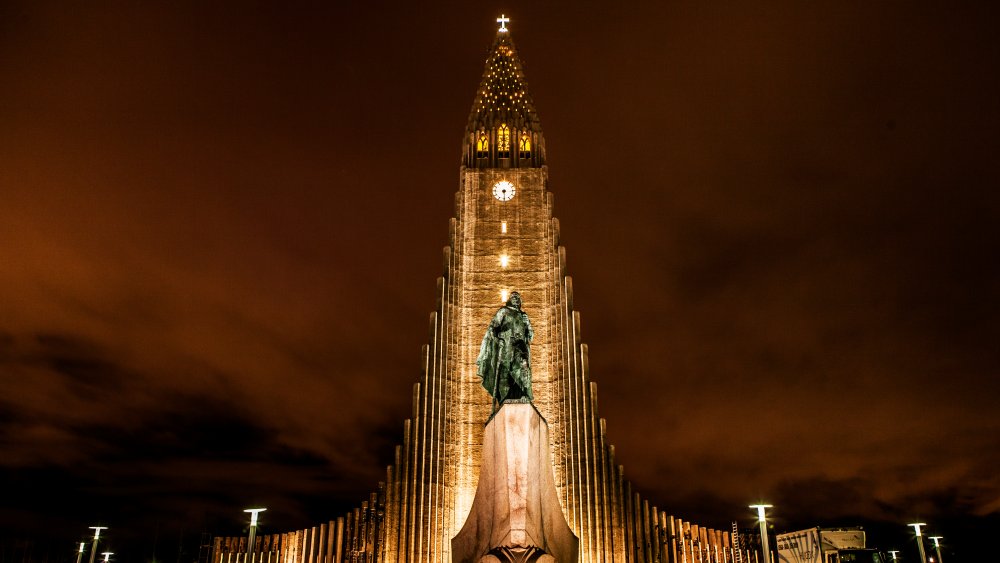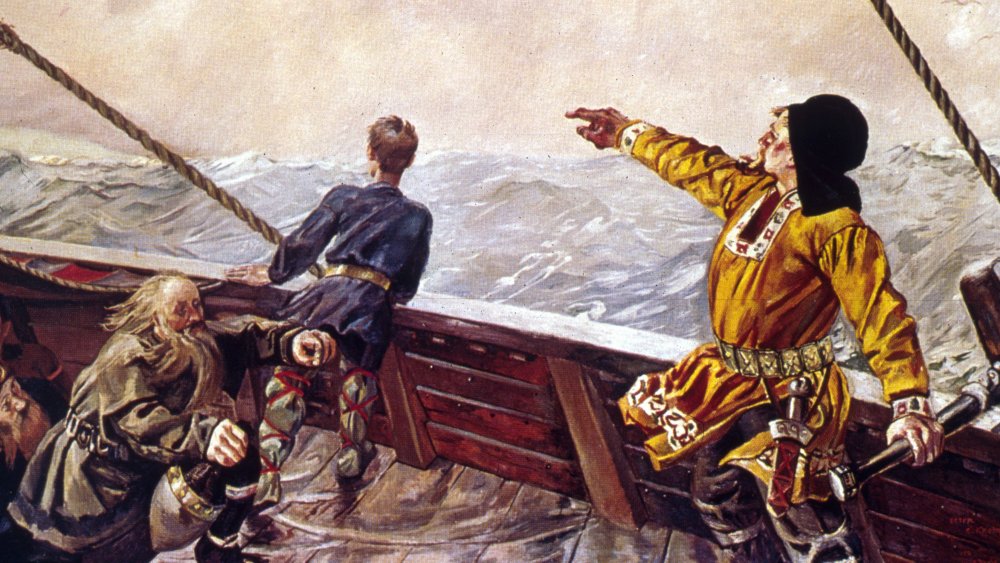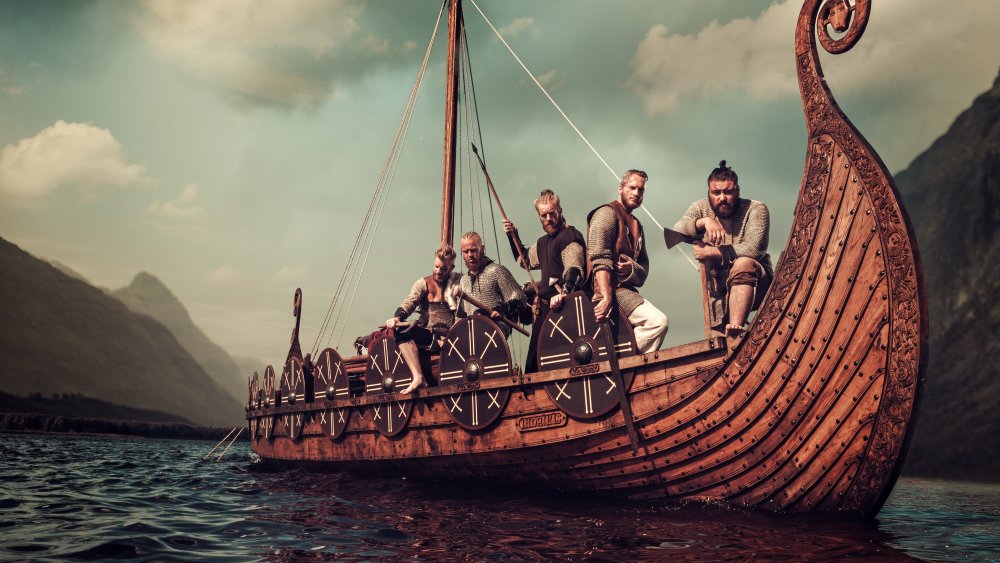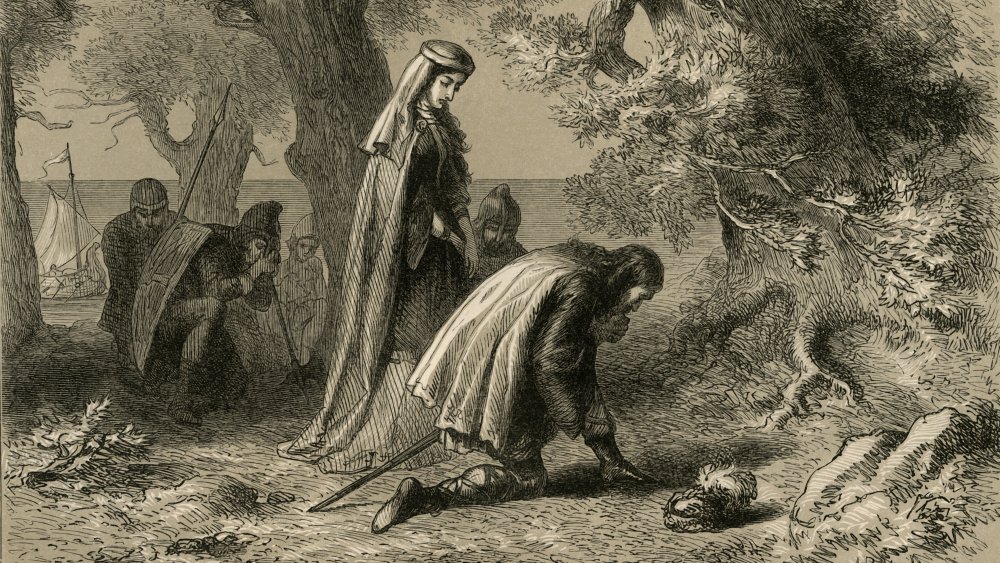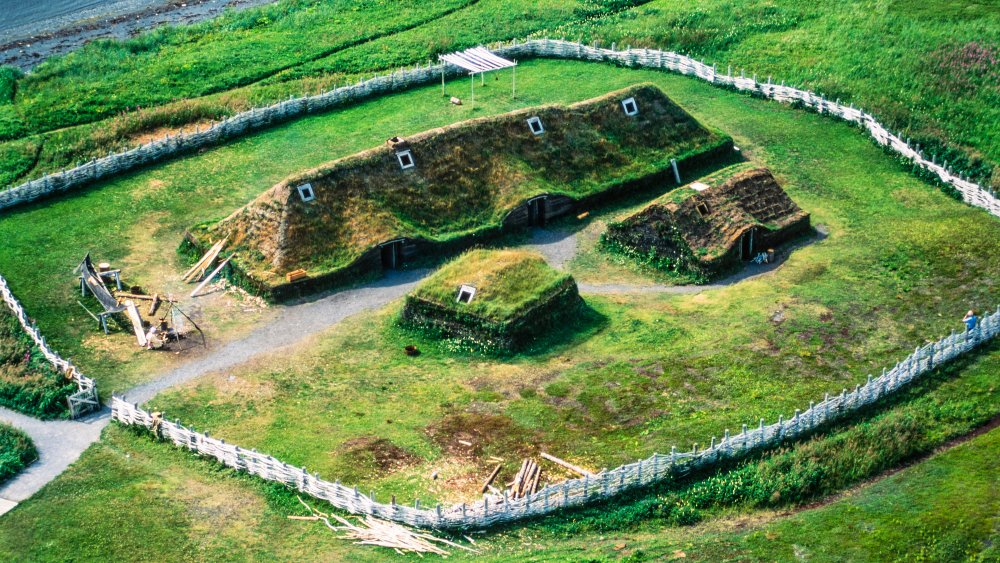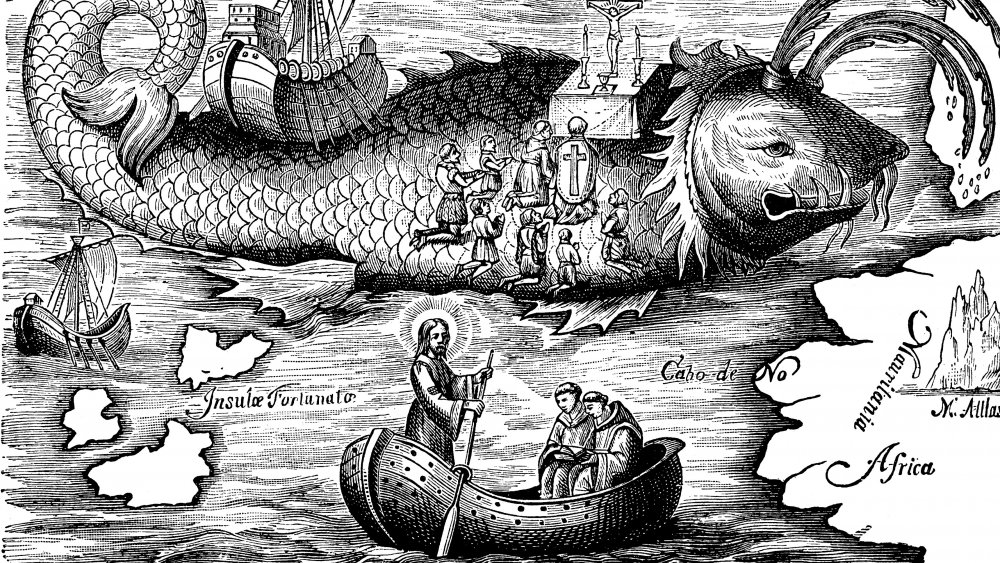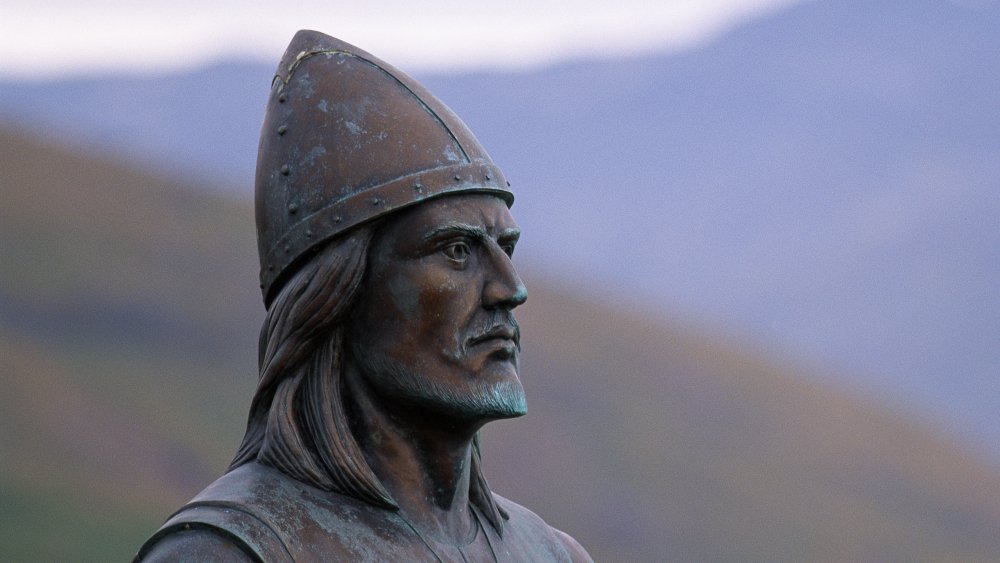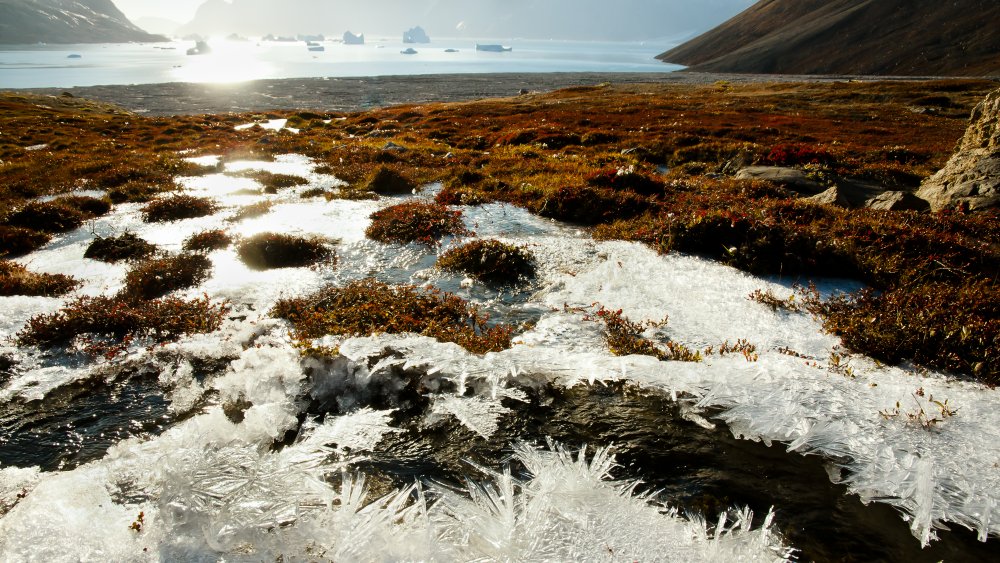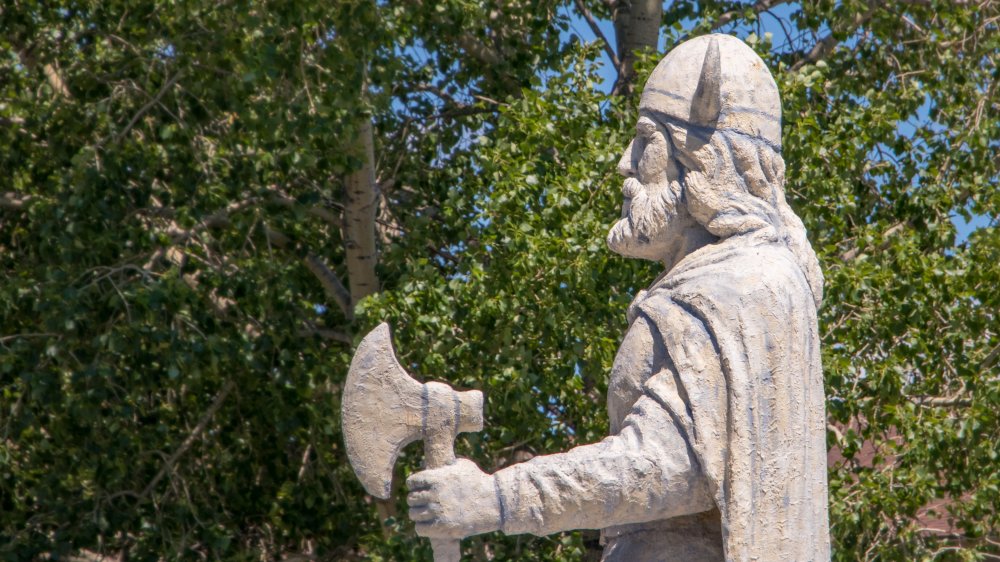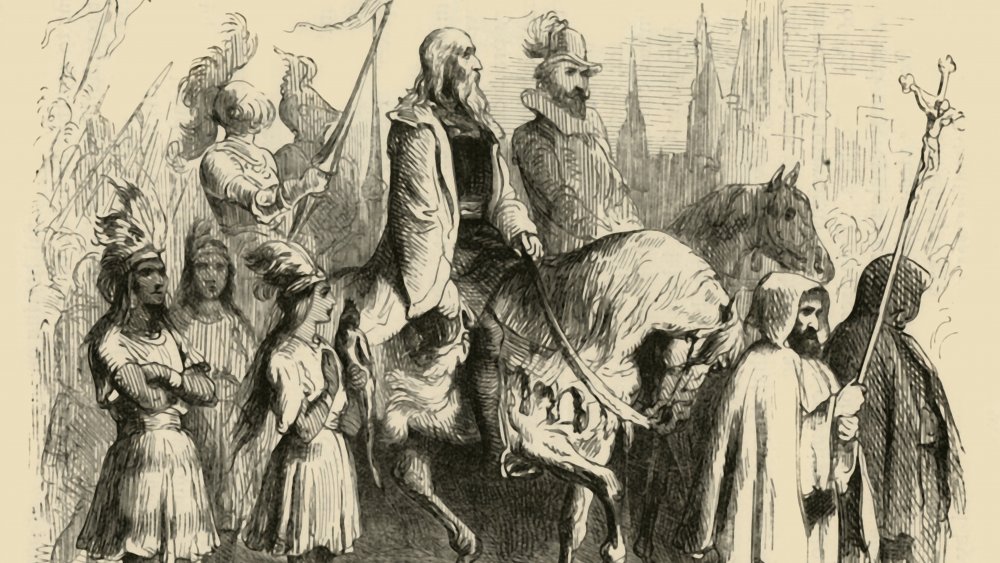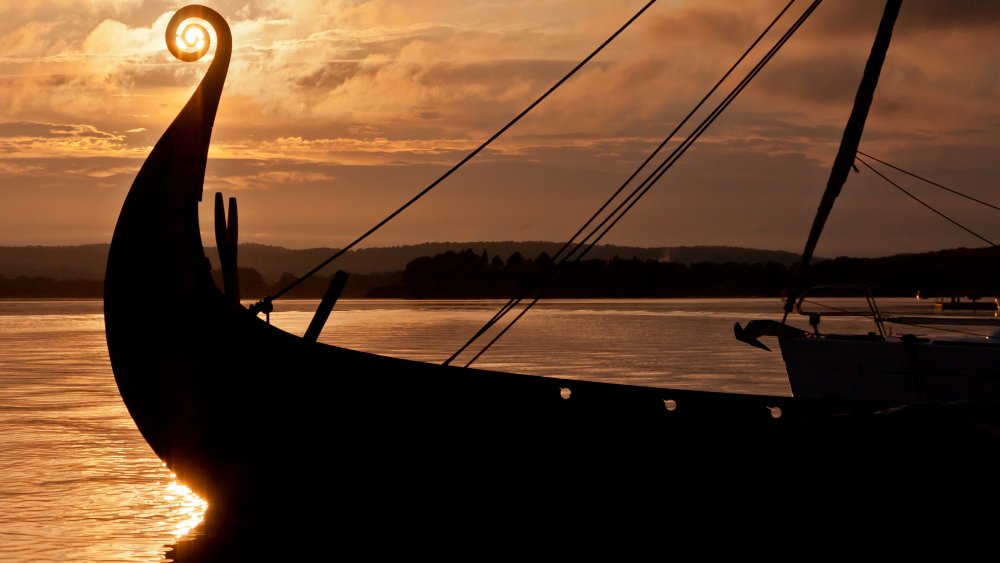How Leif Erikson Became A Legend
When discussing European voyages to North America, it's important to start with a disclaimer: Nobody "discovered" North America. As should be obvious, you can't "discover" a place if millions of people already live there, and to pretend otherwise only further marginalizes the oppressed people who, for centuries, have suffered beneath the horrible brunt of white supremacy.
Now, with that said, it's still fascinating to ponder just how remarkably terrifying those early voyages across the Atlantic Ocean must have been. Between bad weather, disease, and fears of the Kraken gobbling up boats, these journeys were fraught with danger. There were no assurances of making it to your destination, much less making it back home afterward. In light of these unrelentingly menacing circumstances, then, it should be no surprise that historians believe the first Europeans to make the trip were the ever-fearless Vikings, the same warriors who had previously docked in faraway places like England, Iceland, and Greenland. And, while there is some dispute, historians generally agree that the leader of the first intentional Viking voyage to North America was a man named Leif Erikson.
However, while the legend of Erikson has become widely known, the real man remains shrouded in mystery.
The early life of Leif Erikson, son of Erik the Red
If you want to hang out with Leif Erikson, you first have to get to know his father, Erik the Red. The stories of these two men are inextricably bound, not just because they were family, but also because, as History explains, one of the primary sources for information about both of them is a 13th century Icelandic manuscript generally translated to English as "The Saga of Erik the Red."
Now, Erik (actually named Erik Thorvaldsson) was a fairly impressive figure in his own right, since he was the Norse explorer who, upon being banished from Iceland, established the first Viking settlement on Greenland sometime around 980 CE. It is presumed that his son, Leif, was born on Iceland sometime before this exile, according to the Ancient History Encyclopedia, but grew up in Greenland, which remained his central hub for most of his life. Erik the Red, allegedly, was the one who gave Greenland, AKA Grœnland, its bizarre and contradictory name, as a way to convince (I.E., trick) other people into following him there.
There's not much documentation about young Leif's childhood, but one can extrapolate that, since his father was a devoted follower of classic Norse beliefs, Leif would've been surrounded by the various symbols and practices of Norse mythology, as well. His family lived on a farm in a land called Eriksfjord, and throughout his youth, fellow Icelanders arrived and set up their own farms in neighboring areas.
Leif Erikson, the Viking who became a Christian missionary
Religion, as it happens, would eventually become a point of contention between Erikson and his dad. Why? Because after Erikson came of age, the Ancient History Encyclopedia reports that he took a boat to Norway — with, it's worth noting, an unexpected stopover in the Scottish Hebrides, where he allegedly had a love affair with a noblewoman named Thorgunna — and when he arrived at his destination, he swore his undying loyalty to Norway's king, Olaf Tryggvason. Here's the catch: King Olaf was Christian, and he wanted Erikson to not only convert to Christianity, as well, but also to spread the word of Jesus to those ungodly, Thor-loving "pagan" heathens back in Greenland. You know the drill.
Well, Erikson agreed. For what it's worth, it seems likely that Erikson's Christian beliefs were genuine, given that spreading Christianity became his primary goal from that day forward. The legends plant him as a primary force in getting Greenland aboard the Christianity train ... though historians dispute whether his actual role in this was overinflated, since Greenland was already headed in that direction.
Erikson's religious exploits also created some serious marital problems for his parents. See, Erik the Red was not interested in his son's Jesus talk (and probably hoped it was a phase), whereas Erikson's mother, Thjodhild, converted to her son's faith. This religious dispute even caused Thjodhild to kick Erik out of their marital bed, unless he converted. Yikes.
Leif Erikson's famed journey to Vinland
Okay, so, the reason that Leif Erikson's name is still remembered today — and the reason you're reading this article — is because he and his Viking crew were probably the first European fellas to step foot on North American shores, thereby bridging a distance that hadn't been bridged in eons. Not that they called this unknown place "North America," of course ... or even necessarily realized the landmark nature of their accomplishment. Really, it's hard to know exactly what they thought of it, outside of the mythology.
Anyhow, Erikson and his gang, according to Encyclopedia Britannica, seem to have dropped their anchors on the western side of the Atlantic sometime around 1000 CE. Whether Erikson's arrival was intentional or accidental is a point of historical dispute, but it's generally agreed that he hit up three separate locations in Canada, which he named Helluland (Land of Flat Rocks), Markland (Land of Forests), and most famously, Vinland (Land of Wine). Leif and crew were pretty amazed by Vinland, in particular, and all its natural riches: from the produce, to the timber, to the furs, it was a happening place, full of great stuff to bring back home to Greenland.
Winter was coming, so they presumably spent the season in Vinland — at this point, it seems, without encountering any of the indigenous people already living in the region, though later voyages would go differently — and once the sun came back out, they sailed home.
The disputing accounts of Leif Erikson's journey
While it's nice to think of history as a tidy storybook, that's not an accurate portrayal. If anything, forming clear narratives out of ancient historical events always involves disputes, arguments, and patchy details. The details about Leif Erikson's journey, though, are particularly messy.
Why? For one, as Time Magazine explains, there isn't a huge amount of evidence. That's not to say this voyage didn't happen — it certainly did, as proven by the remains of a Viking settlement discovered in modern-day Newfoundland — but the fine details of said voyage are hard to pinpoint. The only real sources are two accounts, titled Erik the Red's Saga, and the Saga of the Greenlanders, according to the Ancient History Encyclopedia, both of which were written centuries after Erikson's death. Want to bet that there's probably some exaggeration, bias, and conjecture? Good luck on proving it, unless you have a time machine, but there's certainly some details that both sagas disagree with each other on. For instance, according to Biography, while Erik the Red's Saga says that Erikson's arrival to Canada was the result of him being blown off course while trying to get home to Greenland, the Saga of the Greenlanders claims that another Viking explorer, Bjarni Herjólfsson, had previously been blown off course to North America a decade beforehand (but, note, hadn't landed there), an accident which directly inspired Erikson to intentionally voyage to Vinland.
Leif Erikson did not colonize North America
The evils of European colonialism, and the countless lives that suffered from it, are too numerous to list. However, in regard to the legend of Leif Erikson, it's important to point out, as Biography does, that while he and his crew were indeed probably the first Europeans to hit North America, they did not colonize any of the locations they landed, but merely set up a temporary village for the winter. Erikson, as previously mentioned, seems to have not personally encountered any of the Native American people who lived on the continent. While Erikson only enjoyed one North American vacation in his lifetime, his brothers Thorvald Eriksson and Freydis Eiríksdóttir did return, however, they didn't truly colonize the region, either.
Still, people have speculated that some currently unknown crew of Vikings might have gone deeper into the mainland, particularly when it came to a fake archaeological find known as the Kensington Runestone, as described by Atlas Obscura, which seemed to indicate that Minnesota might've been settled by Vikings in the 14th century. While this caused quite a hubbub, as Michigan is a big Scandinavian hub, the runestone proved to be a hoax.
This isn't to say that the Vikings didn't have their own whole problematic history of colonization, slavery, and marginalization of other people — they certainly did — just that they didn't do it in North America.
Where in North America did Leif Erikson land, exactly?
So, in a contemporary context, where exactly can you find Helluland, Markland, and Vinland?
Determining the exact locations is tricky, but while Americans spent a long time claiming (i.e., hoping) that Erikson had landed on what is now United States soil, as Time Magazine explains, the evidence makes it clear that his exploits happened further north, in Canada. Encyclopedia Britannica asserts that Helluland may have been the Frobisher Bay area in the north, or perhaps Cape Chidley, whereas Markland was probably the central coast of Labrador.
As for Vinland, well, it almost certainly was in northern Newfoundland's L'Anse aux Meadows. Why the certainty? Because in 1960, as Time writes, the wife/husband team of Anne Stine and Helge Ingstad found the remains of Erikson's little Viking village there. They had pinpointed this location based on a 1670s Icelandic map, and when they got there, were surprised by how "absurdly easy" it was to find the settlement — all they had to do was ask the locals about odd ruins, and said ruins were pointed out to them.
Were the Vikings really first? What about Columbus, or the Irish monks?
Vikings were almost certainly the Europeans who sailed to North America first, no matter how many times your elementary school told you lies about that horrendous monster, Christopher Columbus, who not only crossed the Atlantic five centuries after Erikson's trip, but also never set foot on North America, nor had any idea it existed. So, you can forget about Columbus' claim to fame, to say nothing of the various other racist atrocities he committed.
What about that lovable old yarn, though, about the Irish monks?
If you haven't heard this before, well, some people claim that the first Europe-to-America voyage was actually completed by a 93-year-old St. Brendan the Navigator, and his rather holy crew, hundreds of years before Erikson. Sounds too quaint to be true? Yeah. As History reports, the Irish story of the voyage to the "Garden of Eden" also included fireball-throwing giants, angels, ox-sized sheep, and towering crystal pillars. Fantasy elements aside, there's no real evidence for the idea that St. Brendan docked in North America, to say nothing of how insanely difficult it would've been for him to cross such a distance in the sixth century. That doesn't mean this crazy voyage absolutely didn't happen — there is speculation about where he might've gone to, even if it wasn't North America — but for now, in the absence of proof, scholars tend to believe the whole tale is just a religious allegory.
Pronunciation and spelling confusion
Quick question, American readers — how do you pronounce Leif Erikson? No looking it up!
If you said "Leef," like so many Americans do, you're doing it wrong. As explained by a footnote in Lister M. Matheson's Icons of the Middle Ages, the more proper pronunciation would be "Lafe." If you've been on the wrong side of this, don't worry, Erikson himself doesn't take it personally. He's been dead for a long, long time.
Now, spelling? That's a whole other subject. The various different spellings of Leif Erikson's name are actually something of a political debate in Norway, according to Peder William Chellew Roberts' exceptionally long-titled work A Frozen Field of Dreams, Science, Strategy, and the Antarctic in Norway (just try and memorize that title), with the Old Norse version being "Leifr Eiriksson," while the new Norwegian alternative is "Leiv Eirikssøn." Life in Norway, meanwhile, also mentions that some English writers use Ericson (instead of Erikson, like this article does). Some people spell it Eriksson, with two Ss, but this is less common. Confusing? Well, just imagine the weird ways that the people of the future (say, 1,000 years from now) might pronounce your name.
Leif Erikson's later years in Greenland
Leif Erikson made history. His exploratory achievements surpassed those of any Viking before him. After sailing back home from Vinland, though, how does a guy top himself? Or, more directly, how long did he wait before heading back out there?
Well ... he didn't. The truth is far more mundane. It seems that Erikson, satisfied by having set foot on Vinland and dabbled in this exploratory lifestyle, simply went back home and lived a relatively quiet existence afterward. Evidently, his later years are said to have mostly involved him converting everybody he could to Christianity. When his old man Erik the Red died, according to History, Erikson took over as the chief of Greenland. Following Erikson's death, his role as top dog was succeeded by his son, Thorkell Leifsson.
However, while Erikson called it quits on Vinland after just one journey, his siblings and in-laws weren't done yet. As Greenland chief, according to the Ancient History Encyclopedia, Erikson gave permission for his brothers Thorvald, Thorstein, and sister Freydis to go back to Vinland, on various occasions, and use the dwellings there. Perhaps the most famous story, of these later journeys, involved Thorvald somehow angering a local indigenous tribe, which resulted in him dying in a storm of arrows.
Leif Erikson's descendant retraced his journey
Looking back, the idea of traversing the Atlantic Ocean in the year 1000 CE seems more like the concept for a horror novel than a journey you'd really embark on. Regardless, the Vikings did it, with Leif Erikson probably leading their mission. And, once this was done, Erikson became a family man, with children and grandchildren.
Thus, about 1,000 years later — AKA, the year 2000 — Erikson's direct descendant followed in his ancestor's footsteps. That descendant was a man named Captain Gunnar Marel Eggertsson, according to the New York Times, who honored his great, great, great (insert X times more greats) grandfather's voyage by constructing a replica of his ancient ship, dubbed Islendingur, and embarking on his own 2,600-mile trip across the Atlantic. Accompanied by a crew of eight, according to the Guardian, Eggertsson went from Greenland to Newfoundland, down to Nova Scotia, and finally to the U.S. ports of Boston and New York. Regardless of whether this particular route was accurate, it's certainly hard to imagine a better thousand-year anniversary tribute to the historic journey.
Hopefully, when the year 3000 rolls around, one of Eggertsson's descendants will do the same.
The dark history of Leif Erikson Day (and Columbus Day)
Given how terrible Christopher Columbus was, Columbus Day has become a controversial holiday, and for good reason. Thankfully, in recent years, an increasing number of cities and states have moved to re-brand the holiday as Indigenous People's Day, thereby acknowledging real history instead of whitewashing the sins of the past. However, even putting aside the false and white supremacy-tinged notion of any European "discovering" America, many contemporary people have wondered why Columbus got a day in the first place, instead of Leif Erikson.
Here's the thing. If you look at October 9th on your calendar, you'll see that there is a Leif Erikson Day. However, as Time Magazine points out, the history of this day, sadly, has its own racism problems.
Long story short, in the early 20th century, there was a big movement to recognize Erikson over Columbus, not because of the facts, but instead, because the Scandinavian Erikson was supposedly "whiter" than the Italian Columbus. Keep in mind, xenophobia and racism were big problems back then, much as they are today, but the "not fully white" immigrants being targeted in this particular instance were Italians. Thus, while there was a big push for a Leif Erikson Day over a Columbus Day, the reasons for this push were deeply troubling ... and ironic, considering the horrifyingly racist crimes that Columbus himself, as pictured above, was guilty of perpetrating upon Native Americans.
Leif Erikson's long legacy
These days, as demonstrated by the popularity of TV shows like the History Channel's Vikings and Netflix's Last Kingdom, there has been a renewed interest in Viking history, particularly as previous stereotypes of them as raging, bloodthirsty brutes are replaced by more nuanced and realistic depictions. As for Leif Erikson, he doesn't have a long history of pop culture portrayals (other than the 1928 film The Viking), and while there probably won't be a prestige HBO series about the voyage to Vinland anytime soon, there is now a widespread acceptance of his place in exploration history.
Since 2015, Iceland has celebrated the Leif Erikson Awards, which honors individuals who either achieve outstanding feats of exploration, or those who promote and/or preserve exploration history in a noteworthy manner. Iceland is also the location of the world's most well-known Leif Erikson statue, as described by Iceland Magazine, which now stands before the Hallgrímskirkja chapel. If you've ever been to Reykjavik, you know the one. Meanwhile, Erikson's likeness has also been used for many other statues, according to the Leif Erikson International Foundation, which can be found across the United States in locations ranging from Milwaukee, Wisconsin to Seattle, Washington.
In the end, though Leif Erikson's role in the history books is complex, and the personal details have been blurred by time and fable, it's quite likely that his name will live on for centuries to come.
